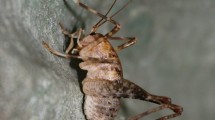Summary
The sensory innervation pattern is described for the femur of the middle and the hind legs ofCarausius morosus. — In one of the nerves (F121) extracellular recordings show a unit which mirrors the tension of the flexor tibiae muscle (tension receptor). The tension receptor increases the firing rate of the slow extensor tibiae motoneuron. It measures the tension of one or more muscle fibres of the anterior side near the distal end of the muscle. The anatomical basis of this receptor is uncertain. — Another receptor was found on the ventral side of the distal end of the apodeme of the extensor tibiae muscle (apodeme receptor). Recordings from this receptor could not be obtained inCarausius. But inExtatosoma tiaratum it responded to stretching of the nerve. In the natural position it shows a minimum of excitation in the 90°-position of the femur-tibia-joint and an increase in firing rate for both flexion and extension. — Tactile hairs react phasically and have no special sensitivity for one direction. Two receptors at the dorsal side of the femur-tibia-joint (RDAL and RDPL), which are situated in the same position as inSchistocerca hind legs, react phasically to extension movements and fire tonically in the most extended position of the joint. — The influence of these receptors on the position of the femur-tibia-joint is only weak.
Similar content being viewed by others
References
Bässler, U.: Der Regelkreis des Kniesehnenreflexes bei der StabheuschreckeCarausius morosus: Reaktionen auf passive Bewegungen der Tibia. Kybernetik12, 8–20 (1972)
Bässler, U.: Reversal of a reflex to a single motoneuron in the stick insect,Carausius morosus. Biol. Cybernetics24, 47–49 (1976)
Bässler, U.: Verhaltensphysiologie bei Stabheuschrecken. Biol. Zeit7, 48–54 (1977)
Burrows, M., Horridge, G.A.: The organization of inputs to motoneurons of the locust metathoracic leg. Phil. Trans. R. Soc. Lond. B269, 49–94 (1974)
Coillot, J.P., Boistel, J.: Localisation et déscription des récepteurs à l'etirement au niveau de l'articulation tibio-fémorale de la patte sauteuse du criquet,Schistocerca gregaria. J. Insect Physiol.14, 1661–1667 (1968)
Coillot, J.P., Boistel, J.: Étude de l'activité électrique propagée des récepteurs à l'étirement de la patte métathoracique du criquet,Schistocerca gregaria. J. Insect Physiol.15, 1449–1470 (1969)
Cruse, H., Storrer, J.: Open loop analysis of a feedback mechanism controlling the leg position in stick insect,Carausius morosus: comparison between experiment and simulation. Biol. Cybernetics25, 143–153 (1977)
Füller, H.: Elektrophysiologische Untersuchungen am femoralen Chordotonalorgan vonCarausius morosus Br. Zool. Jb. Physiol.79, 486–491 (1975)
Füller, H., Ernst, A.: Die Ultrastruktur der femoralen Chordotonalorgane vonCarausius morosus Br. Zool Jb. Anat.91, 574–601 (1973)
Godden, D.H.: The motor innervation of the leg musculature and motor output during thanatosis in the stick insect,Carausius morosus Br. J. comp. Physiol.80, 201–225 (1972)
Heitler, W.J., Burrows, M.: The locust jump. II. Neural circuits of the motor programme. J. exp. Biol.66, 221–241 (1977)
Honomichl, K.: Feinstruktur eines Muskelrezeptors im Kopf vonDermestes maculatus DeGeer (Insecta, Coleoptera). Zoomorphol.85, 59–71 (1976)
Marquardt, F.: Beiträge zur Anatomie der Muskulatur und der peripheren Nerven vonCarausius morosus Br. Zool. Jb. Anat. Ont. Tiere66, 63–128 (1940)
Pflüger, H.J.: The control of the rocking movements of the phasmidCarausius morosus Br. J. comp. Physiol.120, 181–202 (1977)
Runion, J.J., Usherwood, P.N.R.: Tarsal receptors and leg reflexes in the locust and grasshopper. J. exp. Biol.49, 421–436 (1968)
Spencer, H.J.: Analysis of the electrophysiological responses of the trochanteral hair receptors in the cockroach. J. exp. Biol.60, 223–240 (1974)
Storrer, J., Cruse, H.: Systemanalytische Untersuchung eines aufgeschnittenen Regelkreises, der die Beinstellung der StabheuschreckeCarausius morosus kontrolliert: Kraftmessungen an den Antagonisten Flexor und Extensor tibiae. Biol. Cybernetics25, 131–142 (1977)
Weidler, D.J., Diecke, F.P.: The role of cations in conduction in the central nervous system of the herbivorous insect,Carausius morosus. Z. vergl. Physiol.64, 372–399 (1969)
Wilkens, F.A., Wolfe, G.E.: A new electrode design for en passant recording, stimulation and intracellular dye infusion. Comp. Biochem. Physiol.48a, 217–220 (1974)
Author information
Authors and Affiliations
Additional information
Supported by Deutsche Forschungsgemeinschaft
Rights and permissions
About this article
Cite this article
Bässler, U. Sense organs in the femur of the stick insect and their relevance to the control of position of the femur-tibia-joint. J. Comp. Physiol. 121, 99–113 (1977). https://doi.org/10.1007/BF00614183
Received:
Issue Date:
DOI: https://doi.org/10.1007/BF00614183




